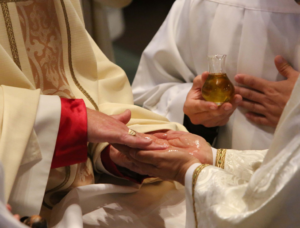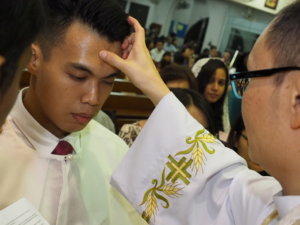Being a professor of theology, people often ask me for recommendations when introducing the Catholic faith to others. What’s the best book to use? Is there a video I can suggest to someone? For years now, my answer to these questions has been the same. If you want to introduce someone to the Catholic faith, attend as many liturgies during Holy Week as possible. Take Thursday and Friday of Holy Week off from work, and live in church. That’s my advice.
Though, in Western Christianity, we have come to see Christmas as the “high holiday” of the year, theologically speaking, it isn’t. Those three days which celebrate the Lord’s passion and culminate in his resurrection, hence the phrase Paschal (Passover) Triduum (three days), are the Christian “high holidays.” They not only re-present the mysteries of the Lord’s suffering, death, and resurrection, but – if I am to be counted among the saints – they are the story of my salvation. If I am saved, it is because I am mystically joined – through faith and baptism – to Christ on Calvary. St. Paul makes this same point to the Christians at Rome. “[A]re you unaware,” he asks them, “that we who were baptized into Christ were baptized into his death? We were indeed buried with him through baptism into death, so that, just as Christ was raised from the dead by the glory of the Father, we too might live in newness of life” (Rom 6:3-4). To use another reference, on Good Friday many of us no doubt will sing the African-American spiritual “Were You There?” Well, if I am united to Christ, the answer is “Yes”!
Many of these liturgical celebrations are very familiar to us: Holy Thursday’s Mass of the Lord’s Supper, Good Friday’s Celebration of the Lord’s Passion (not Mass), and the Easter Vigil on Holy Saturday. Along with the Way of the Cross (Via Crucis) – traditionally celebrated during the day on Good Friday – these are the most well-known and heavily attended liturgical celebrations during Holy Week. There is, however, another Mass during Holy Week that ought to be added to this list. The Mass celebrated during the day on Holy Thursday is known as the Chrism Mass. It is at this Mass that your local bishop will consecrate the oils used for sacraments (e.g., Confirmation, Anointing of the Sick, etc.) and liturgical celebrations (e.g., the consecration of a church, anointing of catechumens, etc.) in your diocese throughout the year. It is a rich liturgical celebration, and I would recommend that you find the Mass schedule of your local bishop in order to attend; it is not always celebrated, according to the tradition, on Holy Thursday.
But there is more to attracting one to attend the Chrism Mass than just experiencing  something new. Customarily, we are used to commemorating both our Lord’s institution of the Eucharist and the sacrament of Holy Orders at the Mass of the Lord’s Supper. This makes perfect sense, since “[o]n the night before he died, Jesus instituted the Eucharist and at the same time established the priesthood of the New Covenant” (Sacramentum Caritatis 23). Further, the celebration of the Eucharist is at the heart of the priesthood itself (see Pope St. John Paul II, General Audience, 9 June 1993). But while the sacraments of the Eucharist and Holy Orders are most certainly intimately linked, the Chrism Mass – more than the Mass of the Lord’s Supper – is a celebration of the priesthood. In addition to the Blessing of Oils, this Mass contains within it a Renewal of Priestly Promises; and the scriptural readings point to the biblical use of oils for consecrating, i.e., ‘setting apart,’ a person for a holy task or office.
something new. Customarily, we are used to commemorating both our Lord’s institution of the Eucharist and the sacrament of Holy Orders at the Mass of the Lord’s Supper. This makes perfect sense, since “[o]n the night before he died, Jesus instituted the Eucharist and at the same time established the priesthood of the New Covenant” (Sacramentum Caritatis 23). Further, the celebration of the Eucharist is at the heart of the priesthood itself (see Pope St. John Paul II, General Audience, 9 June 1993). But while the sacraments of the Eucharist and Holy Orders are most certainly intimately linked, the Chrism Mass – more than the Mass of the Lord’s Supper – is a celebration of the priesthood. In addition to the Blessing of Oils, this Mass contains within it a Renewal of Priestly Promises; and the scriptural readings point to the biblical use of oils for consecrating, i.e., ‘setting apart,’ a person for a holy task or office.
While the Chrism Mass is perhaps the annual celebration of Christ’s institution of the priesthood, it should also remind us of the holy task to which we are all called. It is a celebration of the ministerial priesthood, established in the sacrament of Holy Orders. But it should also remind us all of the priesthood of all believers, established in the sacraments of initiation. All Christians, by virtue of their Baptism, are called to preach, govern, and sanctify in the world; just as those who have received Holy Orders are called to preach, govern, and sanctify in the Church. All Christians have been set apart for this task, and made “a kingdom of priests, a holy nation” (Ex 19:6; cf. 1 Pt 2:9). The ministerial priesthood and priesthood of all believers both participate in the one priesthood of Christ, and together form one Church (see Lumen Gentium 10).
So if you happen to see a priest on Holy Thursday, it would be an appropriate day to thank him for his ministry. Then consider your own call to holiness, and the grace you have received through Baptism in order to fulfill this call. That’s your priestly vocation!
Anthony Coleman teaches theology for the Saint Joseph’s College Online Theology Program.

